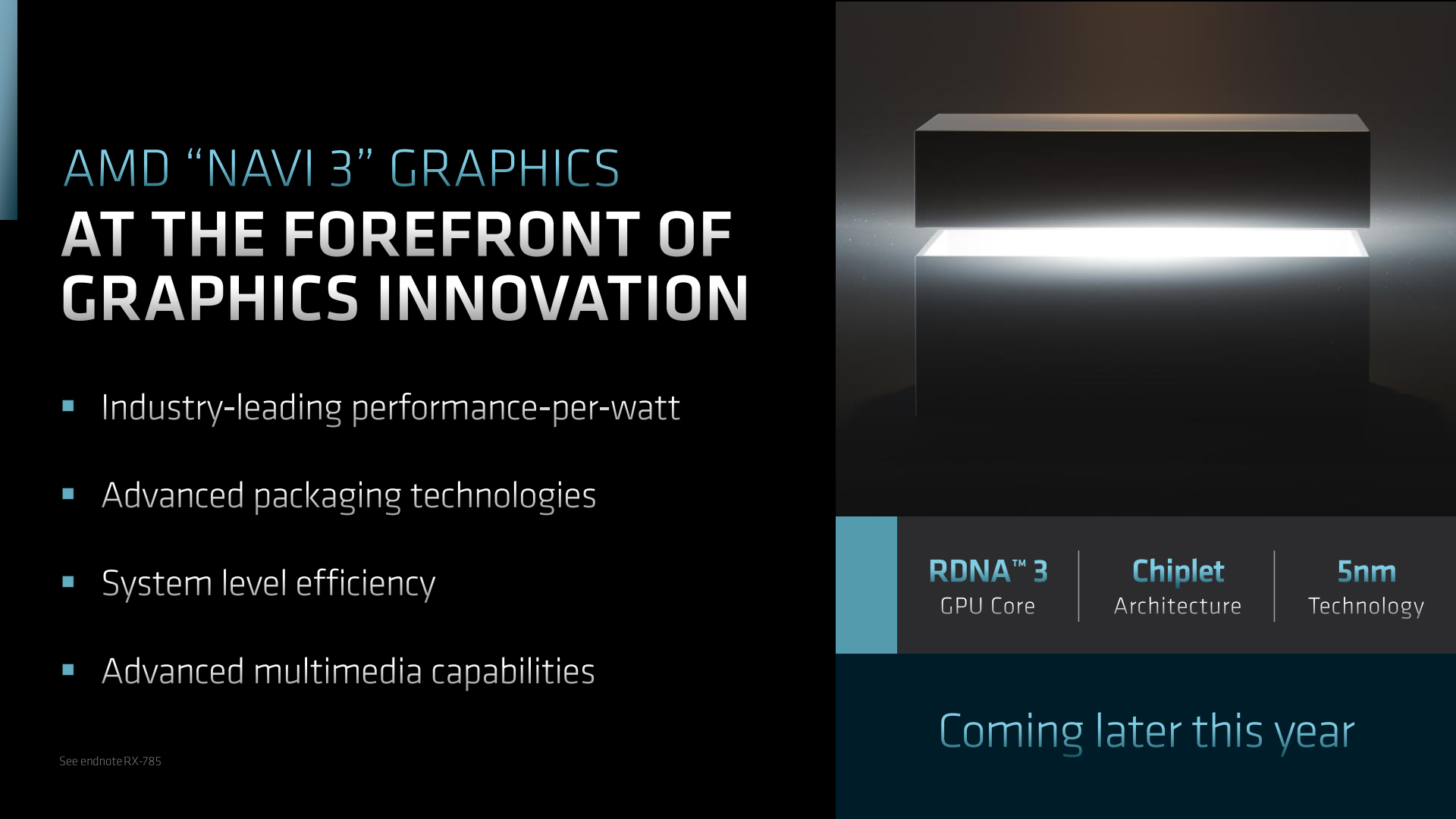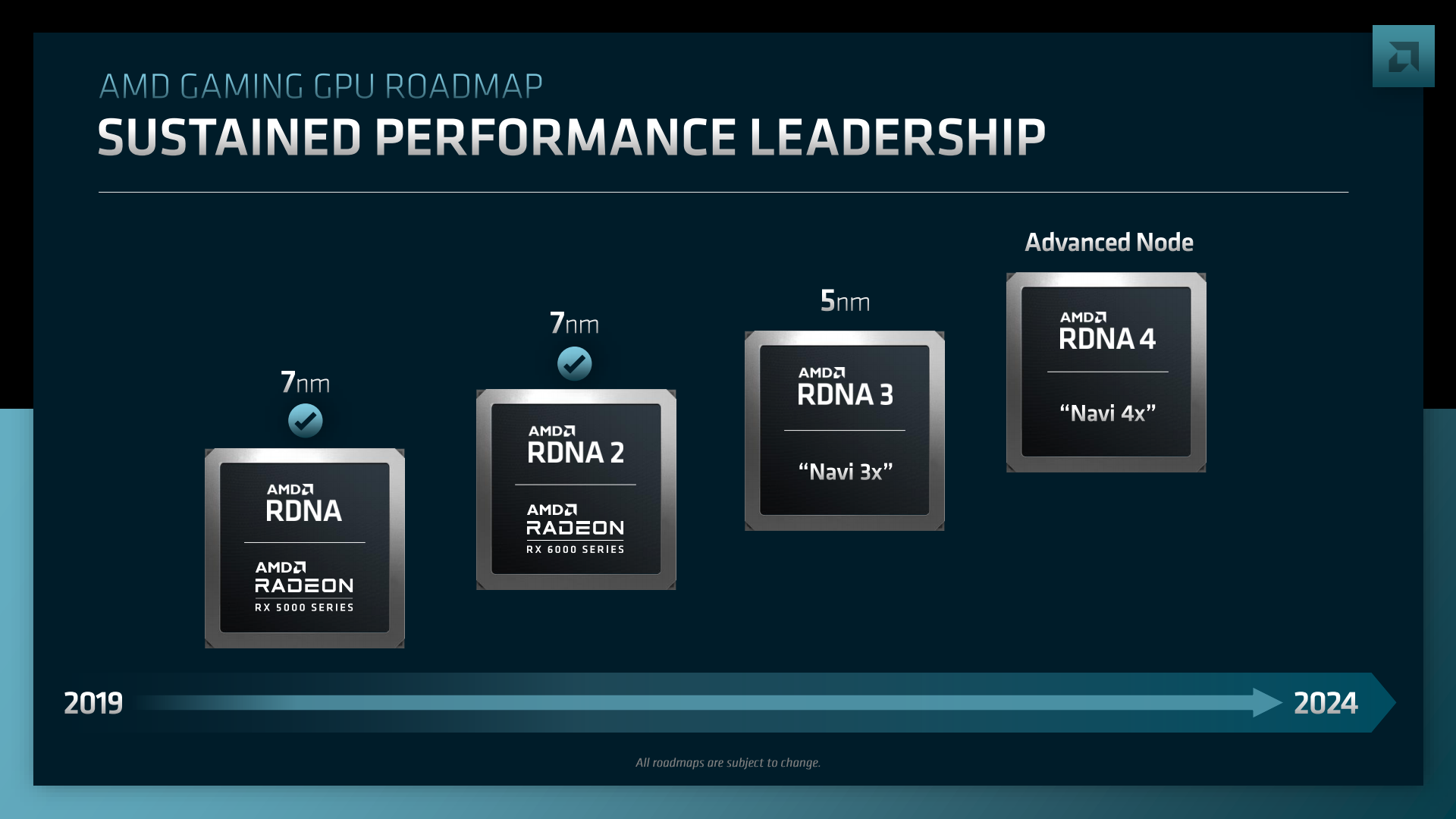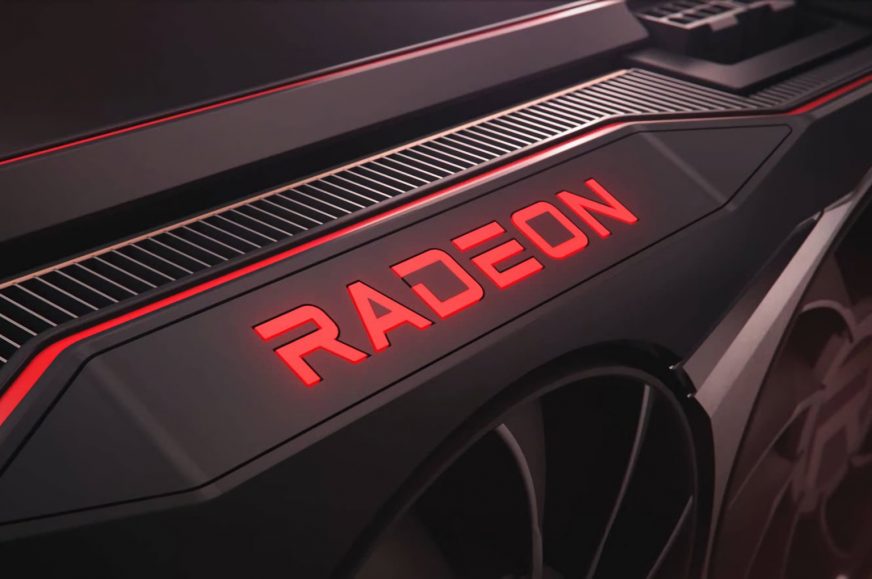AMD shows roadmap of graphics architectures
AMD held its Financial Analyst Day 2022 last week, unveiling their future plans there – we’ve already covered what the company said about Zen 4 processors coming out this year, Zen 5 coming out in 2024, and the processor roadmap (for Ryzen 7000 and 8000, Epyc 7004 and 7005). Besides that, the GPU roadmap with the future RDNA 4 architecture was also presented, and we learned new things about the RDNA 3 GPUs coming out this fall.
RDNA 3: chiplet usage and 5nm process confirmed
AMD has confirmed that GPUs with the RDNA 3 architecture will use a 5nm manufacturing process, which is expected to be one of the sources of their improved power efficiency. According to previous reports, lower models (Navi 33 GPUs) could be 6nm, which the company doesn’t mention here, but it’s probably not out of the question.
Explicit confirmation of the 5nm process should mean that it is either N5 or N5P technology (from TSMC). Nvidia’s competing new GPUs have also long been rumored to use a 5nm process, but the company eventually announced that the compute Hopper accelerator is built on 4nm node, so its Lovelace gaming GPU could also go on and use a 4nm process. It still means a derivative of 5nm technology (Nvidia uses a custom variant called “4N”, it’s hard to say whether it’s derived directly from the N4 process or N5/N5P), so it’s not some revolution compared to 5nm manufacturing. But it may bring a few percent improvement in energy efficiency or performance.
In addition, AMD has now confirmed that the chips use “advanced chiplet packaging”, so they will not be a monolithic piece of silicon, but a combination of several chiplets. It’s not yet clear what exactly is meant by this. Previously, it was assumed that the compute units themselves would be split in multiple pieces of silicon (which would create a sort of “GPU Threadripper”). But it’s also possible that the compute part will be a monolithic die, and AMD could attach extra cache on the base chip in the form of extra chiplets, as it started doing this year with processors with 3D V-Cache. The same Direct Bonding technology could be used in such case. We will have to wait to confirm exactly how the chiplet approach will be used.

New compute unit architecture, new Infinity Cache
The RDNA 3 architecture will not just be a conversion of RDNA 2 to a smaller manufacturing process. It seems it might even be a bigger architectural change than RDNA 2 was with regards to the first generation RDNA. The presentation states that the architecture of the compute units themselves has been overhauled for RDNA 3, compute unit being the basic GPU building block containing shader units, texture units and also Ray Accelerators for raytracing effects in games. No further details are given, but this could be a major change and it is possible that it will significantly affect “IPC” (by which we mean GPU’s performance at a given number of compute units and at a given constant clock speed).
AMD states that the overall “graphics pipeline” will be optimized, so there could probably be further changes in other fixed units such as ROP or geometry engines. Again, it’s not elaborated further , but it could be another sign that RDNA 3 represents a bigger architectural advance.
AMD has also confirmed that RDNA 3 GPUs will use Infinity Cache technology, which is a large cache integrated directly in the GPU that boosts power efficiency and performance by significantly improving the effective bandwidth of the memory subsystem, as much of the hot data is held in this cache by the GPU and does not need to be fetched from GDDR6 or GDDR6X memory. The RDNA 3 architecture is supposed to get “next generation” Infinity Cache, which hopefully means improved capabilities (perhaps higher capacity or performance).
>50 % better energy efficiency
As a result of these improvements and 5nm manufacturing, RDNA 3 GPUs are expected to achieve much higher performance at the same power as RDNA 2, or the same performance at significantly lower power. The performance to power ratio is said to improve by more than 50 %. It is said to be “industry leading”, but that doesn’t necessarily mean it will be higher than what the competition will come up with.
The company has kept the exact number to itself for now, and it’s possible that it’s not yet known, as there may only be ES samples of the GPUs available now – according to leakers, production is a few weeks behind the Zen 4 processor production, so qualification samples with final specs may have yet to arrive. Also, the software stack optimizations are probably still ongoing.

In any case, these power efficiency numbers are only roughly indicative for graphics cards, as they depend heavily on what you choose to compare, as some cards within the same generation are set up much less efficiently (example: GeForce RTX 3070 versus 3070 Ti, or RTX 3090 versus 3090 Ti). So, for now, it’s probably not possible to draw any prediction along the lines of a theoretical future Radeon RX 7900 XT with RDNA 3 architecture would have 150 % of the performance of the RX 6900 XT, or two and a quarter times its performance if it also increased power draw to 450 W (by 50 %).
AMD also mentions in the presentation that these new GPUs will have improved multimedia support (anecdotal leaks suggest there’s a chance for an AV1 hardware encoder) and that it will somehow improve overall “system efficiency”. Not long ago, AMD’s Robert Hallock hinted that the company may be considering deploying laptop-like graphics switching technology in the desktop given that the Ryzen 7000s will have integrated GPUs. Then, in gaming PCs, high-performance dedicated GPUs could be turned off when not gaming and only activated when a GPU-intensive program is running. This would result in improved idle and light-usage power draw. But there is no confirmation that this is indeed already in the pipeline for the next generation of GPUs and CPUs.
Roadmap: RDNA 4 in 2024
In addition to the CPU and APU roadmaps, a roadmap of future architectures was also shown, which already includes a successor to this year’s RDNA 3. This will be an architecture named RDNA 4, and even the individual GPUs are to be named “Navi 4x” (so for example Navi 41, Navi 42). So not much surprise in the naming.
This architecture is said to come out in 2024, so at least we have a handle on when the next big generational change will take place. AMD, it seems, will once again stick to the two-year cadence that has been the standard for Nvidia for the last decade as well.

We only know that the manufacturing process will no longer be 5nm. AMD calls it “Advanced Node”, which judging by the roadmap of processors (Zen 5) can be either a 3nm process, but also just 4nm node. Perhaps the technology is not yet decided and will depend on what shape the 3nm process TSMC starts off in – if it seems to suffer problems, AMD may probably at some point opt to retarget the new generation of GPUs for the 4nm process. This could befall the Zen 5 CPUs, or perhaps some processors of that architecture may be 3nm but some just 4nm.
This scenario is probably a bit less likely for GPU chips (or chiplet complexes) than for CPUs, so RDNA 3 GPUs are more likely to be made with 3nm technology. Indeed, the high performance advances required from new generations of graphics cards tend to depend heavily on the improved energy efficiency of major new process nodes. Of similar importance, however, could also be the question of whether AMD will again use TSMC’s manufacturing process or whether they may switch supplier to Samsung. Currently TSMC’s equal-numbered processes are significantly better (although we don’t know if this will also be true for 3nm technology, on which Samsung will deploy new GAAFET transistors but TSMC will not). And we don’t yet know whose process AMD will choose, though a change of supplier is probably less likely than keeping the continuity.
Sources: AMD (1, 2), AnandTech
English translation and edit by Jozef Dudáš, original text by Jan Olšan, editor for Cnews.cz
⠀








